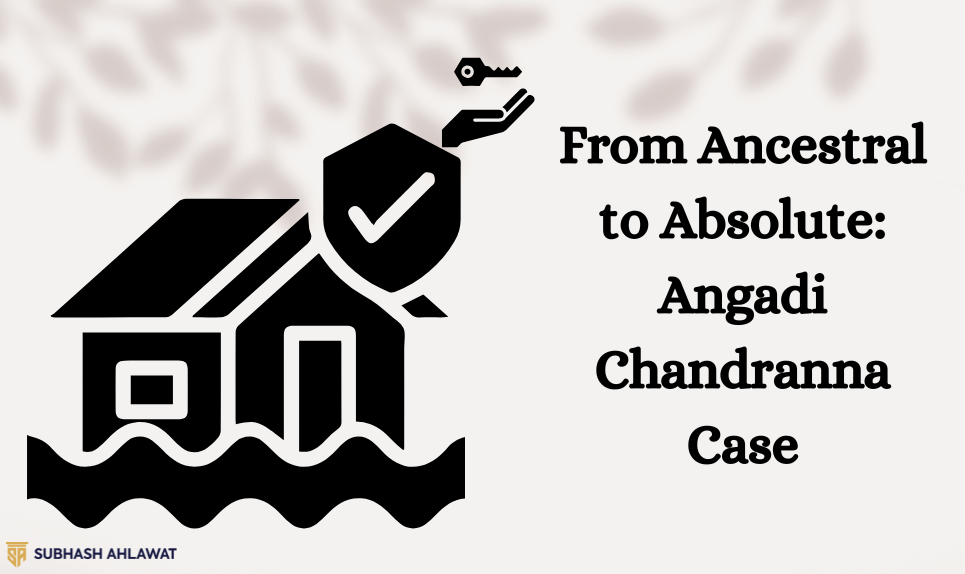From Ancestral to Absolute: Angadi Chandranna Case Redraws Hindu Family Property Lines

On 22 April 2025 the Supreme Court of India delivered its judgment in Angadi Chandranna v. Shankar & Others, Civil Appeal No. 5401 of 2025 (arising out of SLP (C) No. 6799 of 2022). The decision, reported as 2025 INSC 532 / 2025 LiveLaw (SC) 494, revisits two inter-linked themes of Hindu family property law and civil-procedure jurisprudence:
Whether a share that a coparcener receives after a registered partition continues to be ancestral property for his children, or instantly becomes his self-acquired estate with full rights of alienation; and
How far a High Court may re-appreciate facts in a second appeal under Section 100 of the Code of Civil Procedure, 1908 (CPC).
The ruling sets a fresh precedent for joint-family property disputes by affirming that once partition is complete, each allottee’s share becomes self-acquired property, unless there is proof of subsequent blending or use of joint-family funds. In parallel, it rebukes High Courts for straying into factual re-assessment while exercising limited second-appeal jurisdiction.
Factual Background
The Parties and the Suit Property
Defendant No. 1 (C. Jayaramappa) and his two brothers executed a registered partition deed on 9 May 1986, splitting their late father’s Hindu-undivided-family (HUF) holdings.
Under the deed, Sy. No. 93 (7 acres 20 guntas, Mahadevapura Village, Chitradurga district, Karnataka) fell to brother Thippeswamy.
In October 1989, Defendant No. 1 bought this land from Thippeswamy for ₹15,000 by a registered sale deed.
On 11 March 1993 he sold it onward to Defendant No. 2 (the appellant, Angadi Chandranna) for ₹20,000.
The Litigation Cascade
1994 – Trial Court (O.S. No. 169/1994).
Plaintiffs (sons and daughters of Defendant No. 1) sued for partition and separate possession, alleging the 1993 sale was void because the land was still ancestral.
The trial court decreed in their favour.
2002 – First Appellate Court (R.A. No. 291/2002).
Allowed Angadi Chandranna’s appeal, holding the land to be self-acquired and dismissing the suit.
2021 – High Court of Karnataka (R.S.A. No. 1417/2006).
Reversed the First Appellate Court, restored the trial-court decree, and framed what it called a “substantial question of law” on the ancestral-vs-self-acquired character.
2025 – Supreme Court.
Angadi Chandranna appealed. The apex court granted leave, heard the matter, and allowed the appeal, overturning the High Court.
Issues Before the Supreme Court
Whether the land in Sy. No. 93 retained the character of ancestral/coparcenary property after the 1986 partition, such that Defendant No. 1 lacked power to alienate it without his children’s consent.
Whether the High Court, in second appeal, exceeded its jurisdiction under Section 100 CPC by re-appreciating evidence and substituting its own factual findings for those of the First Appellate Court.
Rival Contentions
Appellant (Angadi Chandranna)
Partition Finality. Because the 1986 partition deed gave each brother an absolute share, that share became the holder’s separate estate.
Self-Acquisition Proven. Defendant No. 1 purchased the land in 1989 with his own funds and a private loan, not out of joint-family nucleus.
No Prayer to Cancel Sale Deed. Plaintiffs sued only for partition, not for cancellation of the 1993 conveyance, rendering the relief legally defective.
Section 100 Breach. The High Court’s exercise was a de novo factual reevaluation forbidden in second appeals.
Respondents (Plaintiffs / Children)
Continuing Ancestral Character: Under classic Hindu-law doctrine, property that a father buys with income traced to his earlier ancestral share remains ancestral for his sons; the burden lay on the defendants to prove pure self-acquisition.
Nucleus Presumption: The father lacked independent means to raise ₹15,000 within three years; purchase funds must have come from the joint-family nucleus, keeping the character ancestral.
Bad-Faith Sale: The 1993 sale lacked legal necessity and was executed to fund Defendant No. 1’s “bad habits,” making it voidable
Supreme Court’s Analysis
1. Scope of Second Appeal under Section 100 CPC
Justice R. Mahadevan, speaking for the Bench comprising himself and Justice J.B. Pardiwala, opened with a stern reminder:
“By any stretch of imagination, the question framed by the High Court is not a substantial question of law. What the High Court undertook was a venture into pure questions of fact.”
Relying on Jaichand (2024), Hero Vinoth v. Seshammal (2006), and Chandrabhan (2022), the Court re-stated settled principles:
A High Court cannot re-appreciate evidence unless the lower courts have ignored material evidence, relied on inadmissible evidence, or committed a perverse error.
Section 103 allows factual determination only in narrow, clearly spelt-out circumstances — absent here.
Hence the High Court’s judgment “stood on shaky jurisdictional ground” and had to fall.
2. Character of Property After Partition
(a) No Presumption of Joint-Family Property
The Court re-affirmed that mere existence of a Hindu joint family does not create a presumption that particular property is joint; the claimant must first prove a nucleus capable of the acquisition.
(b) Partition Breaks the Coparcenary Tie
Citing Rukhmabai v. Laxminarayan (1960), Yudhishter v. Ashok Kumar (1987), and modern commentary, the Bench held:
“Upon a registered partition deed, each coparcener’s allotment becomes his separate and exclusive property, alienable at will. The sons and daughters are not taken by birth in that allotment.”
This principle, the Court observed, had been muddied by some earlier High-Court rulings but is now “beyond doubting.”
(c) Burden to Prove Nucleus and Blending
The plaintiffs were unable to show — through concrete books of account, crop-sale receipts, or credible testimony — that joint-family income furnished the ₹15,000 purchase price in 1989. For the doctrine of blending to apply, there must be proof of a voluntary, unconditional throw-in of self-acquired property into the family hotchpot with clear intention, which was absent.
(d) Consequence: Sale to Appellant Valid
Because the land was Defendant No. 1’s self-acquired estate, he needed no consent from his children and could convey perfect title to Angadi Chandranna. The absence of any relief seeking cancellation of that deed further weakened the plaintiffs’ case.
The Court’s Holdings
High-Court Judgment Set Aside. The Supreme Court restored the First Appellate Court decree dismissing the suit.
Property Declared Self-Acquired. Sy. No. 93 stood lawfully transferred to Angadi Chandranna.
Costs. Parties were directed to bear their own costs. (The Court, however, signalled displeasure at “avoidable” litigation and urged awareness-raising on Section 100 limits among the Bar and Bench.)
Doctrinal Significance
1. Re-affirmation of Post-Partition Self-Acquisition
The ruling settles lingering debate on whether a coparcener’s post-partition share remains “ancestral” for his children. The Court prefers a clean-slate theory: after partition, the share is “self-acquired in the hands of the allottee” unless blended back. This has two immediate effects:
Freedom of Disposition: Fathers may sell, gift, or mortgage such property without children’s concurrence.
Estate-Planning Clarity: aughters and sons cannot claim an automatic birthright in their father’s post-partition share; they must rely on inheritance rules or voluntary transfers.
2. Section 100 CPC — A Needed Course-Correction
Indian courts see thousands of second appeals every year. By clipping the High Court’s wings to its true statutory scope, the judgment pushes for quicker disposal and finality in civil suits.
3. Burden-of-Proof Matrix
The decision sharpens the nucleus doctrine: vague allegations of joint-family funds are insufficient. Concrete evidence of income surplus and a nexus with the purchase is indispensable before presumption of joint character can arise.
4. Practical Implication for Conveyancers
Title Verification: Lawyers scrutinising agricultural-land titles must examine partition deeds closely. Post-1986 allotments (or similar) are usually safe to purchase unless specific blending evidence exists.
Drafting Sale Deeds: Recitals should note the partition deed and declare the property self-acquired to foreclose future disputes.
Critical Appraisal
While the judgment strengthens property-law certainty, critics argue it may:
Dilute Coparcenary Protection. Children in agrarian families could become landless if fathers alienate ancestral-turned-separate property without providing alternatives.
Raise Evidentiary Hurdles. Poor litigants may struggle to prove the “nucleus” that often lies in unrecorded cash crops or family labour, effectively tilting the scale towards title-holders.
However, the Court’s line aligns with economic realities of modern India’s land market and the constitutional commitment to equal property rights for women — who, under old coparcenary rules, were excluded.
Conclusion
Angadi Chandranna v. Shankar is more than another partition dispute; it is a re-statement of Hindu property jurisprudence and procedural discipline:
After a valid partition, each share is self-acquired by default.
High Courts must not trespass into facts under Section 100 CPC.
The decision thus provides a predictable rule-of-thumb for families, conveyancers, and trial courts alike: a coparcener’s power to deal with his post-partition property is nearly absolute, and litigants must meet strict burdens to prove otherwise.
In an age of spiralling property prices and inter-generational wealth fights, the ruling is likely to be cited frequently for its clear, concise principles — and for the warning it sounds against judicial overreach in appellate forums.


